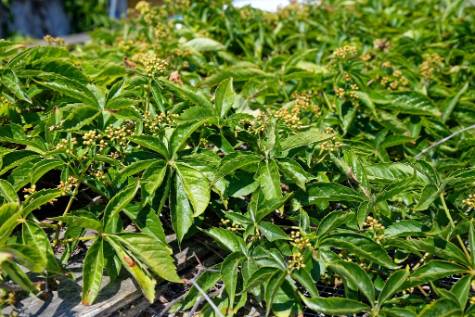Virginia Creeper

Virginia creeper is a woody deciduous vine that is a member of the grape family. It is native to the eastern and central parts of North America, from Canada to Mexico. This plant is often confused with poison ivy as both are deciduous vines that grow in similar locations; however, poison ivy only has three leaflets per leaf, while Virginia creeper has five leaflets per leaf. This vine is very vigorous in its growth pattern and can rapidly grow 30 to 50 feet long or more. It clings to houses, plants, fences, and other structures by adhesive holdfasts or sucker disks located at the tendril ends or will creep along the ground if there is nothing to climb in the area.
The leaves turn a brilliant red in the fall, especially in areas with lots of sunlight. The flowers on this plant are insignificant, but they provide nectar for bees. Songbirds and small mammals enjoy the fruits; however, the fruit is poisonous to humans and can cause nausea, abdominal pain, bloody vomiting and diarrhea, headache, sweating, drowsiness, and death in some cases. Virginia creeper does well in places where it has room to grow or expand. Use it as a vertical screen between houses on a sturdy trellis, or let it run free over the ground in sloped areas to assist with erosion management.
This plant has a high flammability rating and should not be planted near a house where fire is a concern. You should also keep it away from other plants, painted surfaces, or homes, as it can cause severe damage to gutters and wooden shingles or pull the paint off of the walls if left to grow unchecked.

Have questions? Contact our office where our Horticulture Extension Agent will assist you with questions.
Phone: (316) 321-9660
Email: callae@ksu.edu